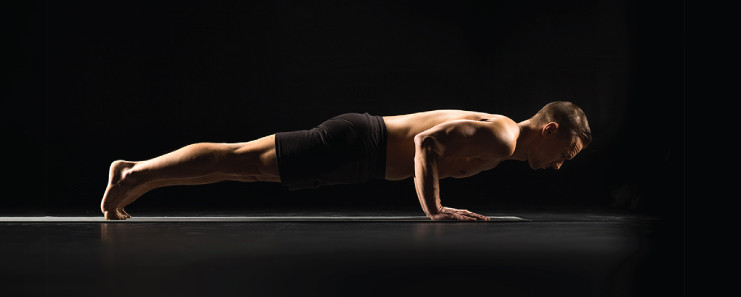Chatur means four; anga means limbs; Danda means staff (here, it refers to the spine of the body); asana means pose.
It is pronounced as cha-thur-anga Dhan-daa-sana.
This yoga pose is frequently practiced as part of the Surya Namaskar or Sun Salutation pose.

How to do the Chaturanga Dandasana/ four-limbed staff pose
- Sit in vajrasana.
- Walk your hands forward and come in plank pose (dandasana) with your hands under your shoulders.
- Straighten your legs, till they are a few inches above the ground and parallel to it, with your toes turned inwards.
- On exhalation, bend your elbows until your shoulders are at the same height as your elbows.
- Exhale. Come up to plank pose. Exhale.
- Sit in vajrasana.
Chaturanga Dandasana for beginners
Start with a shorter time frame and gradually increase it. You can hold this pose for 10 seconds at first, and then for a little longer each time depending on your comfort.
Benefits of Chaturanga Dandasana/ four-limbed staff pose
- This asana strengthens the wrists, arms, and shoulders.
- It also helps straighten the spine, and strengthen the back and abdominal muscles.
- It helps keep the body aligned, maintaining core stability.
- It helps increase stamina. Sportspersons do the plank pose as part of cooling down exercises after playing.
This pose is also a follow-up pose after the adho mukha svanasana or downward-facing dog pose.
Contraindications of the Chaturanga Dandasana/ four-limbed staff pose
Avoid practicing this asana if you have high blood pressure, headache, back, shoulder or hand injury, or are in the latter stages of pregnancy.
Yoga practice helps develop the body and mind, bringing a lot of health benefits; yet, it is not a substitute for medicine. It is important to learn and practice yoga postures under the supervision of a trained Sri Sri Yoga teacher. In case of any medical condition, practice yoga postures after consulting a doctor and a Sri Sri Yoga teacher. Find a Sri Sri Yoga program at an Art of Living Center near you. Do you need information on programs or to share feedback? Write to us at info@srisriyoga.in.
Written with inputs from Meena Waghray, Faculty, Art of Living
FAQ's on Chaturanga Dandasana
Chaturanga Dandasana or four-limbed staff pose. Chatur denotes four; anga denotes limbs; Danda denotes staff (danda refers to the spine of the body); asana means pose. Many practices this as part of the Surya Namaskar. A very effective asana for increasing stamina.
"Benefits of Chaturanga Dandasana: *Asana to strengthen wrists, arms, and shoulders. *Asana to straighten the spine and abdominal muscles. *Asana to strengthen the core and align the body. *Asana to increase stamina. Sportspersons usually practice this asana to increase their stamina."
"Steps to do Chaturanga Dandasana: *From Vajrasana walk your hands forward and come in plank pose with your hands under your shoulders. *Straighten your legs and turn toes inwards. *Exhale and bend your elbows till your shoulders are at the same height as your elbows. *Exhale and come to plank pose. *Exhale and sit in vajrasana."
Dandasana or staff pose or stick pose. Danda means stick or staff and asana means pose or posture. The body is simply seated with the legs straight in the front. The spine is straight and tall like a danda. Legs are also straight like a stick.
"The advantages of Dandasana: *Stretches hamstrings and calves and makes them flexible *Improves posture *Strengthens and lengthens the spine *Stretches the back muscles *Stretches shoulders and chest"
Vajrasana helps to control obesity and increases blood flow to the lower abdomen. Vajrasana improves digestion. This relieves excessive gas in the stomach region.
Don't do Parvatasana in spinal injury and spinal abnormalities, frozen shoulder, and arthritis.
"Sit comfortably on the floor. Stretch your legs forward to keep the toes pointed upwards. Maintain your back straight and tall. Hands remain on the floor beside your hips palms facing the floor. Gently press the floor with your palms and further straighten your spine. Hold the pose for 30-60 seconds. Keep deep breathing. Slowly come out of the asana while exhaling."
Dandasana is full-plank position.
"Tadasana is simple standing asana. In this asana, the body is stretched upward. You can keep your hands beside your body or stretch it up. Parvatasana is a simple seated asana also known as mountain pose. Some consider seated tadasana as parvatasana. Sit in padmasana/ardha padmasana/sukhasana, stretch both hands up from the base of your spine in namaste posture. In both postures keep your body still."
"Parvatasana is a simple seated asana also known as mountain pose. Sit in padmasana/ardha padmasana/sukhasana, stretch both hands up from the base of your spine in namaste posture. Benefits of Parvatasana are: Lung capacity increases. Abdomen, tummy, hips, and waist flab reduces. Spine and ribs stretch."
Kapal Bhati Pranayama is done first which is for warming up the body.
